

 The South African
The South African
by J O E O Mahncke
Kenilworth, Cape Town
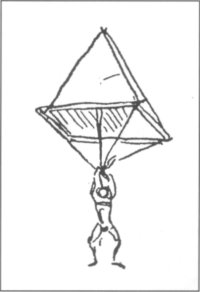
Parachute design by Leonardo da Vinci, c 1500
(Source: C H Gibbs-Smith, A history of flying [1985])
Three years into the First World War, a German airship mechanic, Otto Heinicke, developed a parachute which was used as a cushion parachute by pilots and many of the German aces used this device with great success. Other nations also approved his design and the parachutes of the French, British, American and Italian pilots were at least partially based on Heinicke's model.(3) E R Calthrop was the most successful British parachute designer. He called his model the Guardian Angel, a rather unfortunate choice when dealing with prejudiced military men. From 1915 he offered his parachutes repeatedly to the Directorate of Military Aeronautics and other august bodies, only to be just as repeatedly turned down.(4)
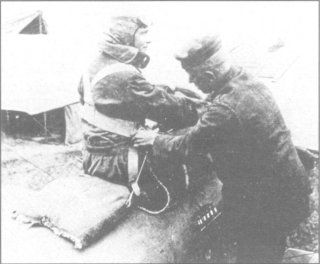
A mechanic attaches a 'Heinicke' parachute to the harness
worn by the pilot of an Albatross DIII
(Source: A Imrie German Army Air Service, 1971)
With observation balloons being used by most of the European armies, commanders on both sides were also first to issue parachutes to the balloonists. Well aware that balloons could not be winched down swiftly enough in case of trouble, they had the observers train in the mastery of parachutes. The packs were hung over the side of the basket and opened by a static line as its wearer jumped. They were the C C Spencer Parachutes for the British balloonists and the Paulus Parachutes for the Germans.(5)
Each captive balloon was manned by an observer and his assistant, who telephoned reports to the ground. Unarmed and barely manoeuvrable, balloons were inviting targets, but they were also resolutely defended by anti-aircraft guns and the 'balloonists usually wore parachutes (sic)'.(6)
The French began to provide balloon observers with parachutes from the end of 1915. It was not such a good solution, because the parachutes of the day were not entirely reliable. For instance, the French model would not open one time in a hundred. And even if they were suspended for immediate use with the observers already harnessed in them, it was difficult to evacuate the balloon quickly as 20 000 cubic feet of hydrogen ignited over their heads. The parachutes fouled too frequently, or sometimes only opened to have the burning mass of the balloon fall on them. Therefore, parachutes were to be used only as a last resort.(7) Some observer training centres offered their students a 'free parachute drop' as part of their training, but the offer was invariably declined.
At the front, parachutes were frequently tested with bags of sand as ballast, but a non-emergency jump by an observer, referred to by the British as a 'joy jump', was not a common occurrence. Nonetheless, observers quickly learned at the front and some officers survived four or five emergency jumps.(8) Tragedies did happen, however. When British fighter aircraft armed with rockets attacked German balloons in May 1916, five were shot down in flames and, despite the fact that all the observers were equipped with parachutes, there were no survivors. This may have been due to the fact that they were unfamiliar with the Paulus parachutes with which they had only recently been issued.(9)
The earliest reports of pilots jumping by parachute from aircraft mention a Captain Berry at St Louis in the USA in 1912, and a Frenchman, Adolphe Pegoud, in 1913. Pegoud was a factory test pilot when he was asked to test a parachute invented by a Monsieur Bonnet. This parachute was of the familiar silk canopy construction stowed in a canvas container attached to the outside of the Bleriot monoplane behind the cockpit, with the ripcord connected to the pilot. Pegoud took off and climbed to about 120 metres. He unclipped his safery belt and stood up, pulling the ripcord as he did so. The parachute snapped open, caught the air and yanked him out of the cockpit. He landed unharmed in a tree. Against expectations, the solitary aeroplane did not dive down and crash but, instead, tumbled through the air in a series of loops and turns and landed safely on the ground.(10) This was one of the few documented cases of unmanned aircraft returning to earth and landing perfectly after their engines had stopped. It certainly confirms the excellent flying characteristics of some of the early aircraft.(11)
If the introduction of parachutes in the balloon services of European armies was in no way restricted, this did not apply to the air forces. When the Imperial German Army established its air service (Versuchsabteilung, test unit) in 1910, their few available aircraft had to be treated with the utmost care. These machines were expensive, fragile and temperamental. Pilots were urged to bring them home safely and, during emergency or forced landings, they remained with the Aeroplan.(12)
A skilled pilot always had a chance to land a mechanically defective plane, perhaps only shearing off its undercarriage and breaking a few bones in the process. Nevertheless, in the early days of aviation, fatal crashes did occur. Early German pilots, civilian and military, made no mention of the use of parachutes, and when the war began in 1914, no plans had been made to equip pilots with these.(13)
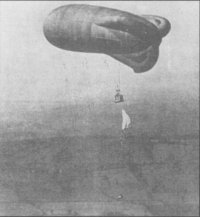
A balloon is used for officer parachute training
(Source: Orbis Publication, War Machine, London, 1985)
The question of supplying pilots of the Royal Flying Corps with parachutes was raised several times at staff level from 1915 to 1917, but the general view remained that 'possession of a parachute might impair a pilot's nerve when in difficulties so that he would make improper use of his parachute.'(14) General Sir David Henderson, General Officer Commanding the RFC, when asked if he wished the experiments with dummy ballast on parachutes to continue, scrawled on the memo 'No, certainly not!' General R M Groves was of the view that 'smashed aircraft generally fall with such velocity that there would hardly he time to think about the parachute'.(15)
The reluctance of Allied commanders to encourage the intensive development and universal use of such life-saving equipment provides a very serious indictment indeed. Until 1917, the only parachutes regularly issued in the aerial services were those issued to the balloon observers and some bomber crews.(16)
As one commentator wrote: 'In those days there were no closed cockpits in aircraft, no heating, no parachutes and no self-sealing fuel tanks.'
Aeronautic experts and senior officers who believed themselves to be experts despite having no flying experience whatsoever, judged that the large size of the parachute and its weight, about 15 kg, prohibited a pilot from clearing the plane with its naked wires and struts sufficiently to avoid the parachute fouling up.(17) This is supported by a clip from the video Fighter Aces, where a photographer filmed a pilot falling from his plane trailing a large, only partially opened, parachute. However, a month or two of research would undoubtedly have resulted in a compact 'seat pack' like the one that was developed in Germany some time in 1916 and perfected by the United States in late 1918. In 1915, however, the lack of the lifesaving canopy of silk caused the deaths of hundreds ofairmen.(18)
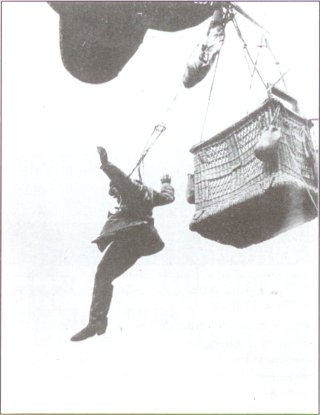
A balloon observer leaves the basket
of an 'AE' balloon using a 'Paulus' parachute.
(Source: A Imrie, German Army Air Service)
Of all the rationalisations used to justify the error in judgement regarding the use of parachutes, one stands out in particular for its apparent lack of compassion. It argued that it was a bad idea to issue pilots with parachutes because this would undermine their fighting spirit: The pilot who knew that he had a chance to bail out would not go into a fight with the same 'do or die' determination as the one who knew that the issue must be to kill or be killed.(19) While high-ranking officers must have seen numerous pilots fall to their deaths, they remained firm: 'The issue of parachutes will undoubtedly reduce this aggressive and fighting spirit because the knowledge that this apparatus is available will soften the pilot's resolve to engage the enemy more closely.'(20)
Many Allied pilots appear to have been of the opinion that the security of a dependable parachute might make it feasible to take a chance once in a while. Yet, many fighter pilots were reckless youths who could be expected to put up a fight under any conditions and many who had parachutes refused to wear them for fear of being thought cowardly.(21) One must be careful of placing the blame entirely on senior commanders, however. Admittedly, most of them had never flown an aircraft and were therefore not in tune with the feelings of their fighter pilots and the multitude of problems they faced during air combat, but this does not mean that all top brass were insensitive.
War Office files which became available for examination
in the sixties seem to lack specific statements by any
officer or official of the Royal Flying Corps, Royal Naval
Air Service, and Royal Air Force who collectively smothered
the development of the parachute. Commander Boothby
(RNAS) wrote: 'We don't want to carry additional weight
merely to save our lives.' Other commentators suggested
that one parachute was sufficient to rescue both observer
and pilot.(22) One of the notable exceptions was General
Longcroft, commander of the 3rd Brigade RFC in France.
A pilot himself, he wrote: 'I and my pilots keenly desire
parachutes and recommend the Calthrop method of fitting
the pack to the top of the fuselage.' All was to no avail,
however, the official reply being: 'This will impose a
dangerous strain on the pilot.'(23) One might ask - more
dangerous than being killed? Another rebuff to Calthrop
was made by Air Board member, General L E O Charlton,
who wrote on the minutes of his request for parachutes to
be used at least in training schools: 'No!'; and when
Calthrop persisted 'in view of the many deaths from the
burning of pilots', Charlton replied: 'Not many.'(24) Judging
from the statistics provided below (30% of aircraft flamed
in mid-air), this seems to have been a poorly informed
reply. In examining the problem of pilot losses in action on
both sides during the period 1914 to 1918, the following
statistics came to light:(25)
German aviation literature only refers to parachutes in connection with observation balloons and Zeppelins before and during the First World War. Parachutes for fighter aircraft are not mentioned. It is only in 1918 that combat reports by pilots include escapes by parachute from crippled aircraft, although it has been claimed that parachutes became available to pilots in 1917.
German bombers were sometimes issued with parachutes, but all references to this are vague, probably due to the disappearance of the squadrons' official war diaries at the end of the war. It certainly made good sense to equip bomber crews, up to eight men strong, with parachutes, bulky or not, on missions to Britain which lasted four or five hours, as well as to those crews operating on the Russian front or in Macedonia.(26)
The first German military pilots never even used the word 'parachute' and they prided themselves in their ability to bring an aircraft with a stalled engine or structural damage to a safe landing.(27) Rittmeister Manfred Freiherr von Richthoven, the 'Red Baron', never wore a parachute and neither did the other German aces until 1918. Richthoven wrote to his parents: 'He who hesitates in a dogfight will be forced down until he flames or crashes into the ground. I once stood next to a petrol tank on the ground as 100 litres exploded and burned out. I could not remain standing about ten paces away, it was so hot. Now you have to imagine that a tank a few centimetres in front of you explodes and the propeller blows it into your face. I believe one is immediately unconscious and everything else is over quickly.' He also described a dogfight between his brother, Lothar, and a Briton: ' ... the enemy aircraft could not react to my brother's attack so quickly, and soon he was at his back. A few moments later flames shot from the enemy. Then nothing can be saved and the plane crashes into flames.'(28)
On a photograph of officers from Richthoven's No 1 Squadron, taken in May 1918, a few are seen to be wearing a Heinicke parachute harness. It is not known whether Richthoven, who was killed in a dogfight on 24 April 1918, ever wore a parachute.
That parachutes were only issued to German fighters late in the first half of 1918 is confirmed by a report dated 9 January. Leutnant Max Ritter von Muller, leader of Geschwader Boelcke, shot down a British aircraft over Moorslede before straying into enemy machine gun fire from the ground. A tongue of flame shot from his aircraft and, not wanting to burn, he jumped without a parachute and was killed.(29)
Little has been written about the use of parachutes by French, Italian and American aviators, but it can be safely assumed that they too suffered from the lack of 'Guardian Angels'. The US government refused to issue imperfect parachutes, still being developed. Perhaps the pilot's view that 'half a parachute was better than no parachute at all' had not yet registered with the responsible people.(30)
Finally, on 16 September 1918, a declaration from the HQ of the RAF in the field gave authorisation that 'all single-seaters are to he fitted with parachutes forthwith'. One feels ashamed to ask why it took so long.
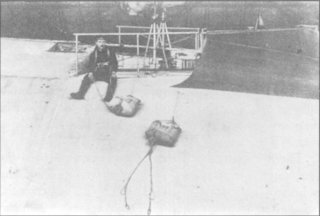
Two 'attach' type parachutes, rarely, if ever,
used operationally, lie on the top gun platform of L22
(Source: R L Rimmel Zeppelin! London, 1984)
Russian pilots did not use parachutes until at least 1917, when the Russian government asked the British Air Board for '100 Calthrop's Patent Safety Guardian Angel Parachutes'. After much haggling the Board sent twenty sets with the proviso that they should not be used for 'aeroplane purposes' as they were considered to be unsuitable.(31)
The first description of a successful parachute jump by a German pilot during a military encounter dates from 27 June 1918, when Leutnant Stembrecher was shot down by a British aircraft and parachuted to safety.(32) During a dogfight on 10 August, a German plane touched the aircraft flown by Leutnant Wentz, causing him to nosedive out of control. He jumped with his parachute and landed safely, only to find himself in the midst of a heavy artillery barrage!(33)
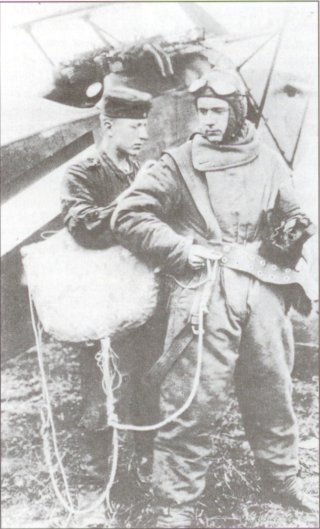
Typical flying kit, c 1918, showing the static line
which will release the parachute from its pack.
(Source: Bryan Philpott, German Air Force)
A graphic description of a parachute escape from a crippled aircraft was given by Oberleutnant Ernst Udet, Staffelfürhrer in the Richthofen Geschwader. On 28 June 1918, Udet attacked a French aircraft but was shot up in retaliation. Unable to bring his aircraft under control, he decided to bale out. At a height of about 400 metres, he stepped on his seat in order to jump. The air pressure was so strong that he was thrown against the rudder and felt a violent blow to his spine. The parachute hooked itself over the tip of the rudder. With the last of his strength, he broke off the edge of the rudder and fell, tumbling, until his parachute opened at a mere 60 metres above ground level. He landed with a hefty bump, but was uninjured.(34)
German airships, also known as Zeppelins after their inventor, Count von Zeppelin, were sometimes issued with parachutes, but these were only provided for a short period. If a Zeppelin became disabled in mid-air through engine, structural or instrument failure, its crew did not evacuate but tried instead to guide the disabled craft to its homebase or at least the safety of friendly territory. If a Zeppelin was struck by enemy fire or anti-aircraft guns, it inevitably began to burn, breaking up into a fireball or exploding, rendering parachutes useless. A report from the commander of LZ22 states that, when returning from a mission, the electrical system suddenly cut out. The airship floundered on and by dawn the crew had reached friendly territory, but they were unable to reach their base. Two fuel tanks were dropped as well as all parachutes. Considering that each parachute weighed 15 kg and that the airship had a complement of eighteen crewmen, this must have been a sizeable reduction in weight.(35)
A eye-witness, Sub-Lieutenant B A Smart of HMS Yarmouth, who shot down a Zeppelin, L 23, on 17 August 1917, reported the following parachute escape from the airship: '... the Zepp was enveloped in flames. An object was adrift from the forward end of the Zepp and which I first took to be some part of the fabric falling off but on looking again discovered it to be a man descending on a parachute. He was the only one...'(36)
A German military history book confirms that 'LZ 66 (L23) was shot down west of Jutland by a British aircraft on 21 August. There were no survivors.'(37)
In conclusion, it is fair to argue that parachutes are another of those if only reflections on the First World War. Sheer ignorance and a reluctance to assume responsibility in the corridors of power, coupled with the stoic acceptance of the inevitable by the young pilots who were expected to face the line of fire unflinchingly, were amongst the reasons for the failure to adopt parachutes earlier in the war. Many young lives might have been saved (fighter pilots were typically aged between twenty and twenty-four years) and the fact that this did not happen is a human tragedy and will remain an enigma forever.
Author's postscript
All Zeppelins were factory numbered consecutively from LZ 1 (LuftschiffZeppelin 1) While the German Army retained the factory numbers, eg. LZ 22, LZ 60, LZ 78 and so on, the German Navy added their own numbers. Thus, LZ 61 (L21) and LZ 74 (L22) were Zeppelins operated by the Navy.
References
11. Supf, Deutsche Fluggeschichte.
12. A Mahncke, 'This was my life'(unpublished autobiography, 1962).
13. Mahncke, 'This was my life'.
14. A Clark, Aces high (Fontana Collins, 1973).
15. AG Lee, No parachute! (Jarrolds Publishers, London, 1968).
16. T R Funderburk, The early birds of war. (Arthur Barker Ltd, London, 1968).
17. Q Reynolds, They fought for the sky. (Cassell & Co Ltd, London, 1958).
18. Reynolds, They fought for the sky.
19. Funderburk, The early birds of war.
20. Lee, No parachute!
21. Kennett, The first air war, 1914-1918.
22. Lee, No parachute!
23. Lee, No parachute!
24. Lee, No parachute!
25. Kennett, The first air war, 1914-19l8.
26. Supf, Deutsche Fluggeschichte.
27. Mahncke, 'This was my life'.
28. M F von Richthofen, Der Rote Kampfflieger(Ullstein-Verlag, Berlin, 1932).
29. Supf, Deutsche Fluggeschichte.
30. Barker, The Royal Fying Corps in France.
31. Barker, The Royal Flying Corps in France.
32. Supf, Deutsche Fluggeschichte.
33. Supf, Deutsche Fluggeschichte.
34. E Udet, Mein Fliegerleben (1935).
35. A Whitehouse, The Zeppelin fighters (Robert Hale Ltd, London, 1966).
36. R L Rimmel, Zeppelin! (Conway Maritime Press, London, 1984).
37. P Meyer, Luftschiffe(Wehr und Wissen Verlagsgesellschaff, Koblenz, 1980).
Barker, Ralph, The Royal Flying Corps in France (Constable, London, 1995).
Bickers, Richard Townshend, The first great air war (Coronet Books, 1989).
Clark, Alan, Aces high (Fontana Collins, 1973).
Encyclopaedia Brittanica.
Funderburk, Thomas R, The early birds of war (Arthur Barker Ltd, London, 1968).
Gibbs-Smith, C H, A history of flying (B T Batsford Ltd, London, 1953).
Gilbert, Martin, First World War (Harper Collins, 1995).
Hackenberger, Willi, Die alten Adler (J F Lehmanns Verlag, München, 1960).
Imrie, Alex, German Army Air Service (Ian Allan Ltd, 1971).
Kennett, Lee, The first air war (The Free Press, 1991).
Lee, Arthur Gould, No parachute! (Jarrolds Publishers,London, 1968).
Mahncke, Alfred, 'This was my life' (unpublished autobiography, 1962).
Meyer, Peter, Luftschiffe (Wehr und Wissen Verlagsgesellschaft, Koblenz, 1980).
Militärgeschichtliches Forschungsamt, Die Militärluftfahrt
bis zum Beginn des Weltkrieges 1914 (Mittler und Sohn, Frankfurt, 1965).
Reynolds, Quentin, They fought for the sky (Cassell & Co Ltd, London, 1958).
Richthofen, Manfred Freihert von, Der Rote Kampfflieger (Ullstein-Verlag, Berlin, 1932).
Rimmel, Raymond Lawrence, Zeppelin! (Conway Maritime Press, London, 1984).
Sholto, Douglas, Lord Douglas of Kirtleside, Years of combat (The Quality Book Club, London,1963).
Supf, Deutsche Fluggeschichte, Vols I & II, (Hermann Klemm A G, Berlin,1935).
Taylor, A J P, HIstory of World War One, (Octopus Books).
Udet, Ernst, Mein Fliegerleben (1935).
War machine (Orbis, London, 1985).
Whitehouse, Arch, The Zeppelin fighters (Robert Hale Ltd, London, 1966).
Acknowledgements
The author would like to express his most grateful thanks to Johan van den Berg of Cape Town and to Cmdr W M Bissett of the South African Naval Museum, Simon's Town, for supplying him with additional research material.
Return to Journal Index OR Society's Home page
South African Military History Society / scribe@samilitaryhistory.org